TGW Limited’s fully integrated automated solution was delivered on time and within budget. It utilised tried and tested book sortation techniques including a number of innovative and unique features that were needed to meet Wiley’s special requirements.
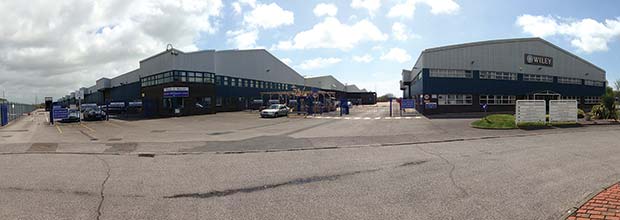
The automated solution improved the efficiency of Wiley’s operational processes resulting in on-going significant labour savings, optimum order accuracy and a considerably faster time to market. Additionally, it has provided Wiley with a multichannel and potentially cross industry solution that can readily accommodate a threefold increase in future capacity.
Overview
Over the past 15 years the Wiley European Distribution Centre (EDC) has been consistently recognised as one of the UK’s leading publisher distributors, four times winner of the UK and Ireland Academic, Professional and Specialist Bookselling Group’s Distributor of the Year award.
The Wiley EDC is a 320,000 sq. ft. single site facility in Bognor Regis, West Sussex that provides Wiley and 14 other prestigious 3PL publisher clients with a range of first class customer service, inventory management and physical book distribution services – primarily to the UK, Europe, Middle East, Africa and Japan.
Customers include internet retailers, wholesalers, high street retail chains, independent bookshops, corporate accounts, academic institutions, governments, and authors as well as end consumers.
In 2012 the EDC had 120,000 SKUs available and 10 million units were shipped to customers in 159 countries across 3.3 million order lines.
As order volumes continued to grow, TGW was tasked with supplying Wiley with a fully integrated materials handling solution that would enable Wiley to triple its throughput, significantly reduce time to market whilst making considerable cost and operational savings.
The Situation
The EDC began as a split site with bulk storage in one building and the main picking and fulfillment operation housed in seven contiguous units on the other side of the estate.
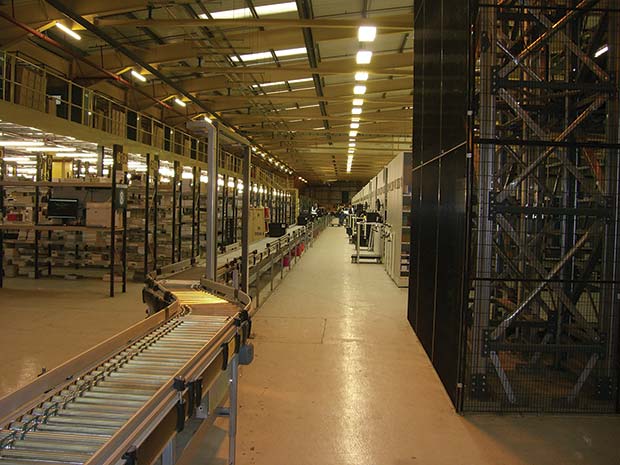
In 2006 Wiley acquired Blackwell Publishing – its largest single acquisition to date. This acquisition, combined with organic growth, and subsequent increasing demand from 3PL clients resulted in the existing buildings nearing storage and operational capacity. This operational capacity was still predominately based on manual processes which were becoming unsustainable.
When a 153,000 sq. ft. unit adjacent to the bulk site became available, Wiley sought to consolidate the two sites and invest in an extensive automated conveyor and sortation solution that would:
• Provide additional capacity to allow for a substantial increase in its 3PL publisher client base.
• Dramatically reduce manual product handling and touch points.
• Absorb future volume growth.
• Make substantial resource and cost savings.
• Improve productivity, accuracy and time to market.
The Process
Following a rigorous tender process, TGW was appointed by Wiley to design, supply, install and commission a bespoke automated materials handling solution. TGW was entrusted with the project based on its past experience with Wiley and its ability to deliver the expected Internal Rate of Return (IRR).
TGW worked in close partnership with Wiley from concept in October 2011 through to project ‘go-live’ in July 2012. A collaborative approach throughout the design process involved thorough investigation of potential technologies by conducting regular site visits and stringent product testing exercises. These included joint visits to reference sites that showcased the equipment of TGW’s preferred sorter partner.
TGW Solution
TGW implemented a fully integrated solution for the picking, high-speed sortation, packing and despatch of books. This consisted of:
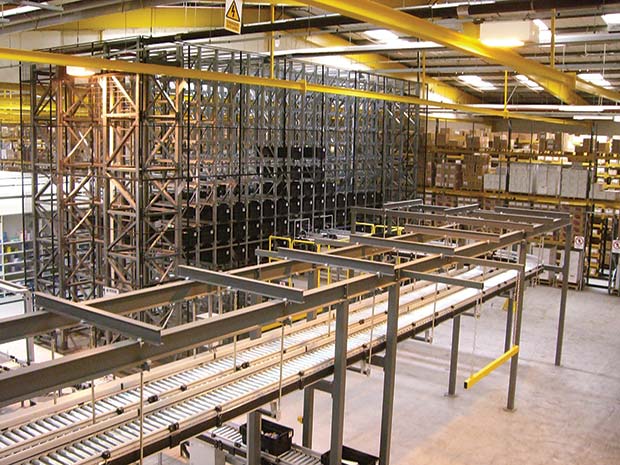
BULK OUTSORT
• Cartoned product is sorted into totes for the appropriate sortation wave, replenishment or single unit orders.
• Scan of SKU on carton activates Put to Light (PTL) technology and allows operator to sort the contents into the appropriate tote.
• Conveyor network routes totes containing books to the appropriate destination.
STORAGE & RETRIEVAL
• Totes are routed to TGW Commissioner with a capacity of 930 totes.
• Designed to store totes prior to sequenced release by sorter wave.
INDUCT
• Totes conveyed to 8 induct stations on mezzanine floor.
• Totes are ergonomically presented to the operator.
• Books removed from tote and placed onto one of two induct belts with barcode up.
SORTATION
• Camera vision system used to obtain image of book bar code and verified.
• Dual split tray sorter selects and deposits books to a unique auto indexing take away belt (257 destinations).
• Flashing green PTL indicates to the operator that the contents for a carton is complete and advises correct carton size.
• Books packed into carton then sent via take away conveyor to ground floor.
PRE DESPATCH PROCESSES
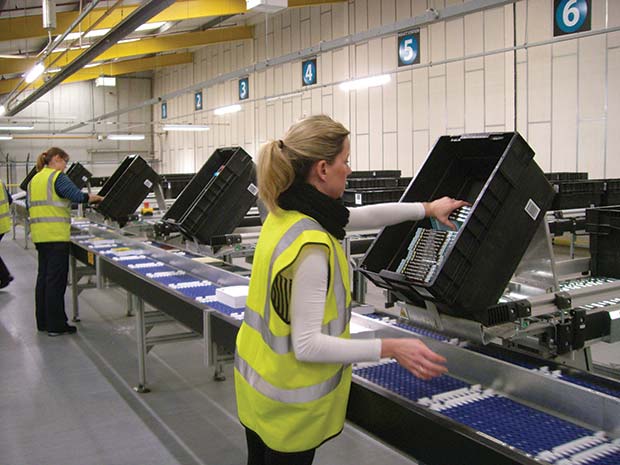
• Cartons conveyed to Documentation Stations if required and Quality Control if necessary.
• Cartons conveyed through void fill, top taping and automatic labelling and strapping.
DESPATCH
• Cartons conveyed to Despatch Sorter feeding 22 lanes.
• Single items sent via totes from bulk outsort and sorter to semi automatic packing machine for processing before routing to Despatch Sorter.
Innovation
The integration of several innovative products was critical to the success of the project and include:
• TGW Commissioner – This is deployed as a dynamic buffer to temporarily store and release totes for sorter waves and offers optimal use of operational space.
• Operator ergonomics – The auto-induct stations are specifically designed to present the books to the operator in an optimum handling position.
This method of inducting provides a highly efficient way of feeding the sorter carriers for maximum utilisation.
• Dual split tray sorter – Operating at high speed, the sorter maintains superior discharge accuracy whilst handling the books with the utmost care.
• Auto-indexing belt exits – These permit the assembly of the contents of a carton prior to packing. Dynamically controlled belt indexing ensures that books are deposited by the sorter minimising any potential damage. The belts were specifically designed and prototyped for the project by TGW engineers before committing all 257 belts to manufacture.
• TGW Warehouse Control System – This customised software interfaces with the Wiley WMS to provide state-of-the-art graphical user displays. These ensure that Wiley has real-time oversight across the entire operation resulting in extremely efficient and flexible resource management.
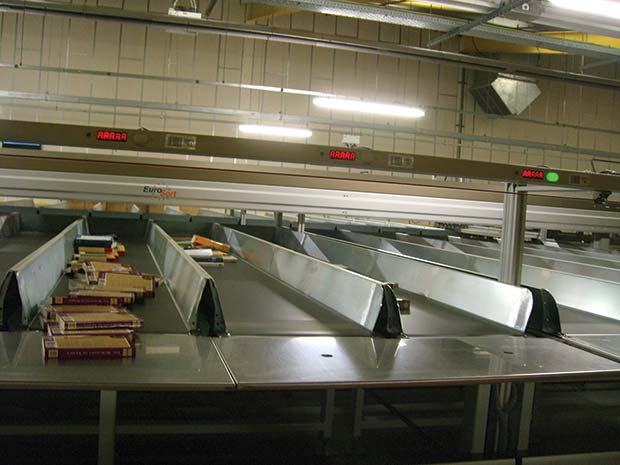
Results
Operational Efficiency
• Since ‘go-live’, Wiley has realised resource savings of 35 FTEs (full-time equivalents), which equates to a 40% reduction of labour in fulfilment.
• The efficiencies delivered by the new system have enabled Wiley to reduce the working day from 3 shifts over 16 hours, to 2 shifts over 10 hours.
Scalability
• The system has inbuilt flexibility to cope with peaks in activity and has the potential to increase annual outbound units from the current 10 million to 30 million.
Accuracy
• The introduction of a camera vision system, as well as presenting the product direct to the operator, has delivered fulfilment accuracy that is now at virtually 100%.
Volume Throughput and Time to Market
• The number of units processed per hour has increased by over 400% from 3,500 to 14,400.
• Wiley have significantly increased their fulfilment and availability for collection/despatch.
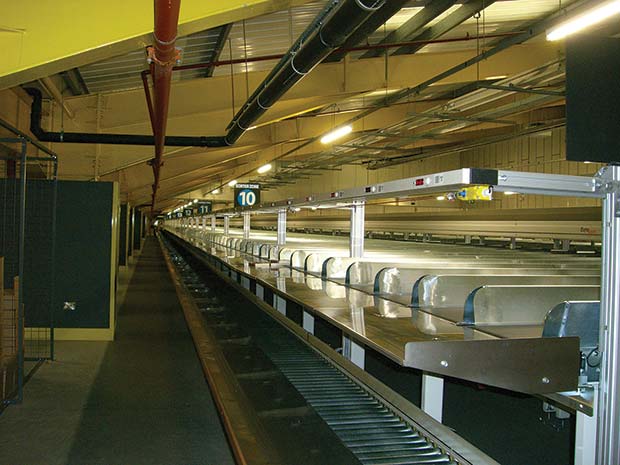
Qualitative Benefits
• Colleagues have commented positively on the acoustics of all the new equipment, which has provided a much improved working environment.
• The ergonomic design in many areas of the system has been recognised and welcomed by staff.
• The installation of the extensive conveyor system and commissioner has eliminated the need to manually handle any totes thus providing a much safer environment for all staff.
 TGW Limited
TGW Limited
Tel: 01858 468 855
email: ukenquiries@tgw-group.com




1 Comment
Pingback: TGW deliver fully integrated automated solution to Wiley ...